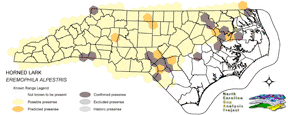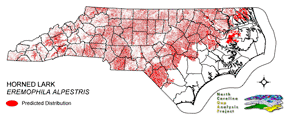
| Taxa: |
| Order: |
| Family: |
| Aves |
| Passeriformes |
| Alaudidae |
| NatureServe Global Rank: |
| NatureServe State (NC) Rank: |
| G5 |
| S4B,S4N |
| Federal Status: |
| NC State Status: |
| --- |
| --- |


| Land Unit |
| US Fish & Wildlife Service |
| US Forest Service |
| US National Park Service |
| US Department of Defense |
| NC State Parks |
| NC University System |
| NC Wildlife Res. Com. |
| NC Forest Service |
| NC Div. of Coastal Mgmt. |
| Local Governments |
| Non-Governmental Org. |
| Other Public Lands |
| Private Lands |
| GAP Status 1-2 |
| All Protected Lands |
| Statewide |
| Hectares |
| 4,568.67 |
| 12,055.59 |
| 7,462.35 |
| 3,389.04 |
| 1,301.22 |
| 205.02 |
| 3,736.71 |
| 278.79 |
| 0.00 |
| 560.07 |
| 973.62 |
| 2,437.02 |
| 2,935,569.42 |
| 12,525.99 |
| 35,892.60 |
| 2,972,537.52 |
| Acres |
| 11,289.43 |
| 29,790.01 |
| 18,439.86 |
| 8,374.50 |
| 3,215.38 |
| 506.62 |
| 9,233.61 |
| 964.53 |
| 0.00 |
| 1,383.96 |
| 2,405.87 |
| 6,022.01 |
| 7,253,948.60 |
| 31,228.01 |
| 88,968.15 |
| 7,345,574.37 |
| % of Dist. on |
| Prot. Lands |
| 12.7 % |
| 33.6 % |
| 20.6 % |
| 9.4 % |
| 3.6 % |
| 0.6 % |
| 9.6 % |
| 0.8 % |
| 0.0 % |
| 2.5 % |
| 2.5 % |
| 5.0 % |
| 0.0 % |
| 34.9 % |
| ----- |
| ----- |
| % of Dist. on |
| All Lands |
| 0.2 % |
| 0.4 % |
| 0.3 % |
| 0.1 % |
| < 0.1 % |
| < 0.1 % |
| 0.1 % |
| < 0.1 % |
| 0.0 % |
| < 0.1 % |
| < 0.1 % |
| < 0.1 % |
| 98.8 % |
| 0.4 % |
| ----- |
| ----- |
|
Uncommon in the mountain region, east to Rocky Mount (Potter et al. 1980) Prefers sparsely vegetated agricultural lands or extensive areas of short grass with scattered patches of bare earth, such as pastures, airports, rowcrop stubble, freshly plowed fields (Nicholson 1997), beaches, and lake flats. Avoids areas with trees or bushes (Kaufman 1996). Nest is built in a small depression on the ground, often next to some object such as a clump of grass or pile or manure. Always forages by walking, picking items from the ground and from plants within its reach (Kaufman 1996). NATURE SERVE GLOBAL HABITAT COMMENTS: Grassland, tundra, sandy regions, areas with scattered low shrubs, desert playas, grazed pastures, stubble fields, open cultivated areas, and rarely open areas in forest (AOU 1983). Nests in hollow on ground often next to grass tuft or clod of earth or manure. |
| Code | Name | Description | NC Natural Heritage Program Equivalent |
| 378 | Ocean Beaches | Open beach sand. | Upper Beach |
| 371 | Maritime Grasslands | Dune grass community consisting of sea oats and beach grasses. | Dune grass, Maritime dry grassland |
| 180 | Agricultural Crop Fields | Farm fields used for row crops. | No equivalent |
| 205 | Agricultural Pasture/Hay and Natural Herbaceous | Farm fields used for pasture grass or hay production, as well as old fields dominated by native and exotic grasses. | No equivalent |
| 214 | Barren; bare rock and sand | Areas of bare rock, sand or clay. | No equivalent |
| 60 | Sand | Exposed sand, predominantly in the sandhills region where disturbance or the extreme site conditions prevent natural regeneration. | No equivalent |
| 202 | Residential Urban | Includes vegetation interspersed in residential areas. Includes lawns, mixed species woodlots, and horticultural shrubs. Vegetation accounts for between 20 - 70% of the cover. | No equivalent |
| 523 | Grassy Bald | High Elevation grassy balds including Pennsylvania sedge, mountain oatgrass, as well as shrubby areas dominated by Alleghany and smooth blackberry. | Grassy Bald |
|
Pickwell, G.B. 1931. The prairie horned lark. 153 pp.
Bent, A.C. 1942. Life histories of North American flycatchers, larks, swallows, and their allies. U.S. National Museum Bulletin 179. Washington, DC. Kaufman K. 1996. Lives of North American Birds. Boston, New York: Houghton Mifflin Company. Nicholson CP. 1997. Atlas of the breeding birds of Tennessee. Knoxville: University of Tennessee Press. Medin, D. E. 1990. Birds of a shadscale (ATRIPLEX CONFERTIFOLIA) habitat in east central Nevada. Great Basin Nat. 50:295-298. Harrison, C. 1978. A field guide to the nests, eggs and nestlings of North American birds. Collins, Cleveland, Ohio. Harrison, H.H. 1979. A field guide to western birds' nests. Houghton Mifflin Company, Boston. 279 pp. Potter, E. F., J. F. Parnell, and R. P. Teulings. 1980. Birds of the Carolinas. Univ. North Carolina Press, Chapel Hill. 408 pp. Terres, J.K. 1980. The Audubon Society encyclopedia of North American birds. Alfred A. Knopf, New York. American Ornithologists' Union (AOU), Committee on Classification and Nomenclature. 1983. Check-list of North American Birds. Sixth Edition. American Ornithologists' Union, Allen Press, Inc., Lawrence, Kansas. Johnson, S.R., and D.R. Herter. 1989. The birds of the Beaufort Sea. BP Exploration (Alaska) Inc., Anchorage, Alaska. 372 pp. Ridgely, R.S., and G. Tudor. 1989. The birds of South America. Vol. 1. The Oscine passerines. Univ. Texas Press, Austin. 516 pp. |
For more information please contact them at:
NC-GAP Analysis Project
Dept. of Zoology, NCSU
Campus Box 7617
Raleigh, NC 27695-7617
(919) 513-2853
www.basic.ncsu.edu/ncgap